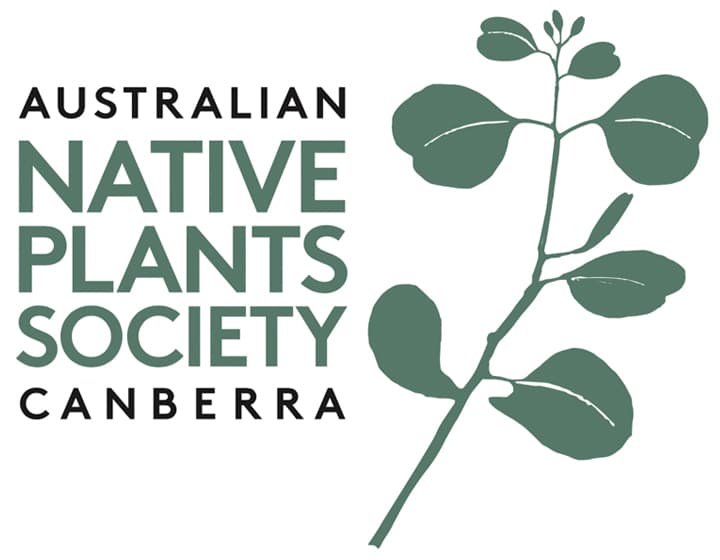Flowering of Proteaceae Family
By Bill Willis
Dec 2022

Recently the ANPSC Daytime Activities Group (16/08/2022) were wandering through Digby Gascoine and Penny Douglass’ marvellous and extensive Campbell ACT garden. During the garden walk we saw a number of Grevillea spp and other members of Proteaceae family, many with their flower buds at the point of flowering (anthesis). A conversation with Janet Russell arose as to why the anatomy of Proteaceae family flowers are clearly different from other angiosperms(flowering plants)?
The Genera of Family Proteaceae include: Adenanthos, Banksia, Brabejum, Dryandra, Grevillea, Hakea, Lambertia, Leucospermum, Macadamia, Mimetes, Orothamnus, Paranomus, Stenocarpus, Telopea and more.
Proteaceae flowers are quite complex and highly specialised in the way parts of the gynoecium (female) and the androecium (male) are arranged (inflorescence), arise, ‘mature’ and pollinate. They do so in such a way so as to minimise self-pollination and to minimise the probability of inbreeding. Pollen carries the male genetic material, ie the male gamete, and is qualitatively and quantitatively half of a seeds genetic package.
Proteaceae family members’ flowers are classified as bisexual, but to ensure the seeds’ genetic diversity, pollen is developed and dispersed prior to any female stigmata becoming receptive to pollen (fertilisation). Species of the Grevillea genus are the most prominent Proteaceae family member and hence it is the focus of this discussion.


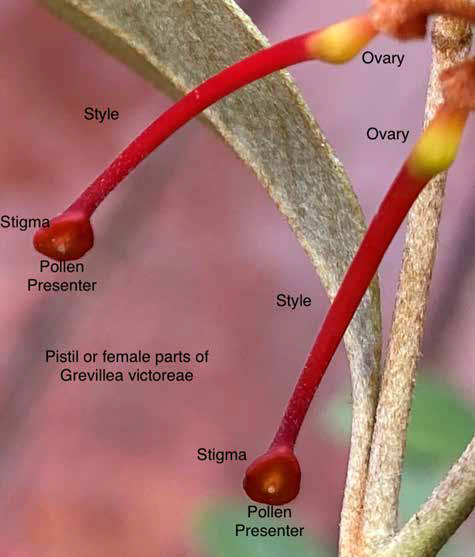
At anthesis the perianth tube of Grevillea species splits longitudinally into up to four tepals of each flower’s perianth. These organs are defined as petaloid tepals as they cannot be morphologically delineated as petals or sepals, they are a fusion of both. Tepals of differing Proteaceae genera may remain split or they may roll back (Grevillea) towards the base. A part of each tepal differentiates into male anthers (the male gamete pollen producing organ). For Grevillea spp the tepals roll back towards the ovary.
Nectar is a sugar-rich liquid produced by plants in glands called nectaries. Nectary glands attract pollinators: insects (native bees, beetles, flies, moths), birds (honeyeaters), mammals (rodents, small animals) and marsupials. The nectary position is within the tepal-stamen whorl. Pollinators can transport pollen to stigmata known as the pollen presenters of other flowers or the pollen presenters of other inflorescences. However, research shows that exotic bees have a very low probability of pollinating Grevillea spp. The exposed female stigma sitting atop its style has an area, a stigmata, known as the pollen presenter, that is receptive to pollen. In time, the lodged pollen grain grows from the pollen presenter down the inside of the style towards the ovary, ultimately fusing with female gamete (ovules) and to eventually form the plant’s seed(s), within the generally woody fruiting (follicles) of Proteaceae.
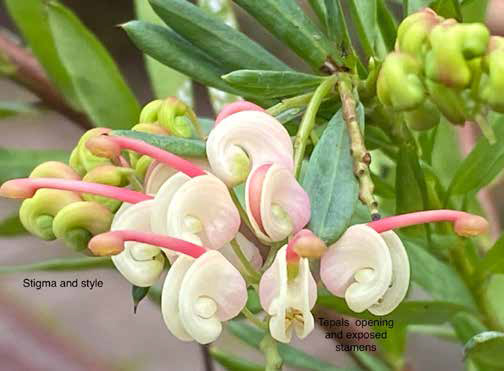
with exposed anthers (male).
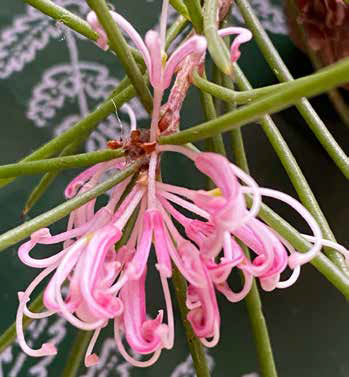

emerging from their perianth.
The absence of male anthers or the remnants of them, in the late stages of flowering indicates the male anthers may become redundant, may have atrophied or may have been consumed as pollinator/ predator food.
References:
Can honeybees pollinate Grevillea? George Taylor; Robert Whelan, Australian Zoologist (1988) 24 (4): 193–196. https:// doi.org/10.7882/AZ.1988.001
PlantNet: Proteaceae Family, https://plantnet.rbgsyd.nsw.gov.au/cgibin/ NSWfl.pl?page=nswfl&lvl=fm&name= PROTEACEAE
Grevillea: https://en.wikipedia.org/wiki/ Grevillea/05
Name That Flower: The identification of flowering plants, Ian Clarke & Helen Lee., Melbourne University Publishing Ltd., Second Edition, 2003, 2009 Reprint.
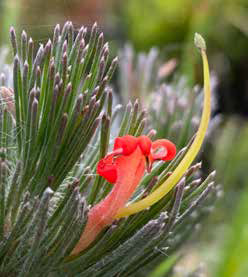
Back to Articles List
